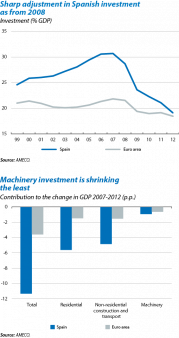Spanish investment is boosted by the foreign sector
Over the last few years, investment in Spain seems to have moved back and forth like a pendulum. The dynamic investment that began after the single currency was adopted was replaced, as from 2008, by substantial contraction. This reversal was so swift it is now difficult to believe investment could ever turn back. However, just like a pendulum, the factors that had brought about this change are now running out of steam and, at the same time, other new forces are starting to gain momentum that could push it back to the other side of the spectrum. What are these factors and how far could they push it?
Let's examine this step by step. Although investment currently seems unlikely to record positive growth rates again, we must remember just how well it performed during the boom years. Not only because of its rate of growth, which was one of the highest in the euro area, but also due to the factors behind this. Between 1999 and 2007, the average rate of growth was 5.6% annually in real terms. Investment was, in fact, one of the main engines of the economy. The increase of its relative weight in GDP (by 6.1 percentage points, reaching 30.7% in 2007) confirms its significant contribution. Residential investment clearly played a key role: it grew at a rate of 6.2% per year boosted by the huge dynamism in the real estate market. But productive investment also demonstrated a notable capacity for strong, sustained growth. For example, investment in machinery became more dynamic and posted, on average, an annual growth rate of 4.0%.
In 2008, the outbreak of the economic recession put an end to this phase, both in Spain and the rest of the euro area countries, although the adjustment was particularly harsh in the periphery. In Spain, real investment shrank by 8.8% annually between 2007 and 2012 (compared with 3.5% for the euro area as a whole). As a consequence, by the end of last year investment's relative weight in GDP had fallen to its lowest level for the last four decades, specifically to 19.1%. This collapse has sounded warning bells regarding investment's capacity to support the economy's recovery over the coming years.
However, one element that helps put this concern into perspective is the smaller drop in productive investment during the recessionary period. In fact, since 2008 a large part of the fall in investment has been due to the adjustment of the imbalances produced during the previous expansionary cycle. That's why the relative weight of Spain's investment in its GDP was still higher than the European average at the end of 2012. The breakdown in investment's contribution to economic growth between 2007 and 2012 substantiates this idea. The components recording a relatively higher deterioration than the euro area average were residential investment and investment in non-residential construction and transport. To a large extent, this disparity with the euro area can be explained by the extensive adjustment in real estate activity starting in 2008 when the real estate bubble burst. This trend contrasts with the smaller drop in machinery investment, with a very similar contribution to GDP growth as the European average.
What might be the force that could once again push machinery investment towards positive growth rates? Given the weakness of domestic demand, the answer lies on the other side of the border. The improved competitiveness of the Spanish economy over the last few years is helping to redirect Spanish production towards export markets. This could allow investment to get back on the road to recovery while the economy completes its different adjustments. The figures provided by the industrial survey of firms for 2011 support this thesis. According to this survey, those industries where the percentage of exports to total sales grew the most between 2009 and 2011 were also the ones that recorded, on average, a smaller reduction in investment. Of note is the pharmaceutical industry which, with the share of exports growing by 9.9%, was one of the few that actually increased its investment during these two years, specifically by 9.8%. These same figures also show that larger firms benefit the most from the support provided by exports. Generally speaking, large companies are more competitive than their smaller peers and are more able to meet the fixed costs entailed by internationalization. In spite of the limited breakdown of these figures, it is clear that those industries with a bigger proportion of large firms recorded a smaller adjustment in investment between 2009 and 2011.
Lastly, one component that should, sooner rather than later, help investment to recover is public investment. To date, this has been one of the hardest hit by the fiscal consolidation programmes of the last few years. Specifically, the net drop in this component accounted for 38% of the public spending cuts between 2009 and 2012, becoming one of the main fiscal adjustment measures. However, there is very little room left to continue cutting public investment so it will be necessary to find formulas that combine fiscal consolidation with a gradual return to public investment, especially in those projects that improve the Spanish economy's internationalization and competitiveness. In the stability programme, however, the relative weight of public investment with regard to GDP is expected to continue falling over the next few years, albeit at a slower rate than seen recently.
In short, although it is true that the adjustment in investment since 2008 has been very severe, the good performance by productive investment in the years prior to the crisis suggests this component's capacity to grow is quite considerable. The fact that it contracted less during the crisis also suggests it is fundamentally resilient. In this respect, the support being offered by exports is very encouraging.
Joan Daniel Pina
European Unit, Research Department, "la Caixa"

